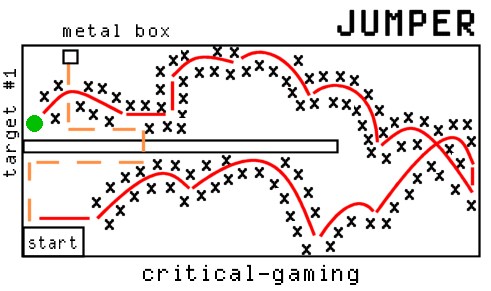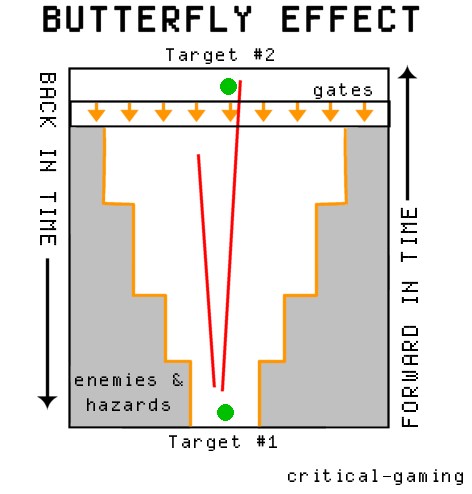DW Lesson 4.1: Pushing Bangai-O
 Monday, October 27, 2008 at 10:17PM
Monday, October 27, 2008 at 10:17PM In the last lesson of the Designer's Workshop, we covered how to dig up inspiration for game ideas as well as how to categorize and develop those ideas to their full potential. Out of the 30 level concepts I have written down for Bangai-O Spirits, I've chosen the following three to create first.
- Jumper: A puzzle stage that focuses on using the diagonal BOOST and release to create arcing "jumps" through space.
- Butterfly Effect: Taking a well known concept from chaos theory, the player will travel back in time and destroy a miniscule target (the butterfly/crease) only to have that action have a devastating rippling effect on history. The passage through time will represented by space creating a very unique folded level.
- World 1-1 & 1-2: The form of these starting levels in Super Mario Brothers will govern the entirety of these levels.
Here's how these game ideas fall on the chart.

...and now for the Push
The follow are the rough concept sketches I created for each level concept and the degrees of push I developed for each.
- red= player path
- green= targets
- orange= destructible element

- The best path (the path of least resistance) through the level can only be traveled on using the JUMP technique. The "x"s in the sketch represents the material that players can BOOST through slowly.
- To ensure players are using the technique, a simple chain reaction gate can be created to put players on a timer.
- Another method to ensure players are using the technique is to replace the slow-BOOST material with the explosive material. One wrong move and it could be your last.
- Can design multiple paths. The hard paths will be short cuts creating a chance for the player to earn a better time by taking the riskier path.
- Can expand the concept so that the player just use the JUMP technique in addition to making precise shots to open up the paths in order to make it to the end in time.

- Fly down to destroy target #1 that unlocks access to target #2. Fly back up to destroy the final target.
- When target #1 is destroyed, enemies that were previously held back along the sides will be unleashed creating a significant threat as the player flies back up.
- Can create a series of pathways at the top of the level so that, by destroying target #1 and all the gates (colored in orange), the player must take a different path to reach target #2 than he/she did in the beginning.
- Destroying target #1 can set off a chain reaction of explosions that create a butterfly pattern. Doing this would cleverly marry a representative form from the concept with the meaning that's communicated via the player's actions within the game world. In other words, this step is the cherry on top.

- The level must look exactly like the classic Mario levels. Must maintain exact proportions.
- The materials should create the "feel" of the classic stages. If bricks are breakable in Mario, they should be destructible in Bangai-O. Translating the function of the elements in Mario in this way is an important step to pushing the level beyond it's looks and shallow nostalgic appeal.
- Enemies should influence the player to move in the same ways Mario does from the common gameplay of Super Mario Brothers.
- The secrets of the stages should be translated into targets. After all, by now we've all internalized the majority of secrets from these first two Mario levels. Doing this will be a key element in bridging the two games by influencing the player in a level that looks like Mario, players like Mario, and finally contains the same secrets as Mario.
In the next Designer's Workshop Lesson, we'll look at how to take a concept sketch and develop it into a smoothly working stage that conveys all of the layers of gameplay and meaning we pushed ourselves to create.


Reader Comments